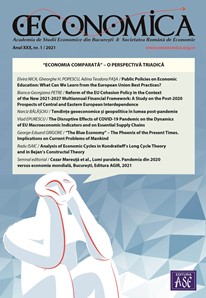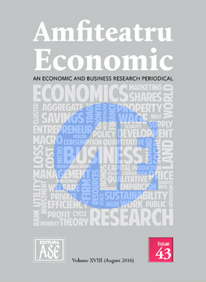
Not Too Big To Fail: The Story of the Rise and Fall of Marmorosch-Blank Bank
Playing a substantial role in the economic and financial progress of Romania in the 19th century, Marmorosch-Blank Bank proudly exemplifies a history of former glory and success and the legacy of a fallen empire which could not hold on to reality and collapsed under the weight of its own ambitions. When one’s national stage is too small, money is not sufficient to buy dreams and the only thing that results when ambition collides with delusion is a very dangerous form of moral hazard.
By financing the most important railway lines in Romania, establishing the basic foundations of manufacturing and the development of the petroleum industry, the bank secured a certain degree of power and influence in the country and the establishment of the Paris, Istanbul and New York branches was a proud statement that Marmorosch-Blank was strong and financially sound and could stand as equal with the big European banks. The promise of greatness was given but never fulfilled, as the Great Depression revealed the sad reality of the early 20th century: a society with an impaired sense of economic knowledge, driven by greed and irresponsible financial judgement. The bank had significant exposure on account of risky investments made in the late 1920s and the events that followed marked the beginning of the end.
Its 100 years of existence gives it a history that reads like a “who’s who” of the most famous bankers of the time. It mingles innovative investment and the laying of the foundation for a country which was perhaps too small for the dream therein and perhaps, most importantly, offers up a lesson for the current generation. It must relearn that those who do not remember the past are condemned to repeat it, as proven by the similarities between The Great Depression and the crises that preceded it since 19th century and which succeeded it until today.
Two founding masters and one brilliant apprentice
Founded in 1848 by the Jewish banker Jacob Marmorosch and his brother-in-law, Jacob Loebel, the institution that was soon to become the most powerful bank in the history of the Romanian economy started up as a minor business with an initial capital endowment of only 30,000 lei.
Because of Loebel’s understanding of foreign trade and his vast influence, the firm became well-recognized on the bourses and markets of Leipzig, as well as London and Vienna, and was granted the benefit of trust in lending money towards their business associates with whom they traded paints, colonial products, iron sheet and other imports. The level of transactions grew as the activity started to focus more on giving loans at a profitable interest rate.
“A good banker is not defined by credentials and how many he has, but by his insight into reality and his ability to fashion it towards his purpose.” (Mauriciu Blank, 1923)
The summer of 1863 marks one of the key-moments in a history of 100 years, as Jacob Marmorosch chooses his own collaborator to be a young student who was not yet 16. With formidable financial abilities, a great vision of the economy and of business based on ground-breaking and rational thinking, the 66 years spent working as a banker granted the name of Mauriciu Blank the hallmarks of accomplishment, success and the title of the greatest Romanian banker of all times.
In 1874, after 11 years in partnership, the bank officially became The Marmorosh-Blank Bank, with a capital of 172,000 lei.
The making of a nation and the making of a bank
 Anticipating the forthcoming importance of the agricultural segment for the economic prospects of the country, the succeeding years of investment focused on agriculture in addition to transport, industry, trade and whatever else could be used to build a diverse, yet solid investment portfolio. In order to achieve its objectives, the bank invested in the laying of some of the most important railway lines in Romania, the construction of bridges, the establishment of large factories, and it was fundamentally involved in the Romanian petroleum sector. Aside from its investments, the bank tried to inspire and support a policy towards greater commercial independence. A token of its patriotism was its reassurance of the foreign market confidence in the economic capability of the country, validating it with arguments proving economic dynamism and with lucrative investment prospects.
Anticipating the forthcoming importance of the agricultural segment for the economic prospects of the country, the succeeding years of investment focused on agriculture in addition to transport, industry, trade and whatever else could be used to build a diverse, yet solid investment portfolio. In order to achieve its objectives, the bank invested in the laying of some of the most important railway lines in Romania, the construction of bridges, the establishment of large factories, and it was fundamentally involved in the Romanian petroleum sector. Aside from its investments, the bank tried to inspire and support a policy towards greater commercial independence. A token of its patriotism was its reassurance of the foreign market confidence in the economic capability of the country, validating it with arguments proving economic dynamism and with lucrative investment prospects.
The preliminary capital was not big enough to stand the market’s demands and the new status established by the bank, so it was enlarged, first to 2,500,000 lei and then doubled to 5,000,000 lei. The succeeding years provided numerous opportunities for the bank to assert its special role in the development progress of the country as it mediated two important loans for the state from Brussels and Berlin, estimated at 5,000,000 lei and 8,000,000 lei, respectively.
During the 1894-1900 period of economic downturn, the bank supported the economy through all means and, after the state repaid its debt of 175,000,000 million, the massive investment in agriculture made by Mauriciu Blank proved to be a real success, with profits soaring in the next few years on account of the good harvests.
At this point, the confidence in Marmorosh-Blank reached its zenith, with bank shares nominally worth 500 lei trading at 920 lei, only 10 days after their official issuance. As a consequence, by 1906, the capital was 8,000,000 lei and seven years later, after various new investments, the capital was 20,000,000 lei.
To underscore its leading role and as a statement of its power which was specific to the age, the bank constructs a monumental headquarters, a true historic monument the size of a palace.

From financing peace to financing defense
The bank displayed great support for the nation throughout World War I, beyond its economic vocation, by turning its palace into a hospital and providing large sums of money for the “Family of Fighters” and other military support groups.
The social and economic life, after the war’s conclusion in 1919, was marked by an inability to accurately assess reality. The telecommunication, transport and the financial systems, as well as the industrial assets, had been extremely damaged, while the labour force was reduced in size due to significant wartime losses. Topping off the litany of woes, the national gold bullion reserves, among other treasures, had never returned from Moscow, which had since been gripped by a revolutionary regime.
After the war, the inflation rate was nearly 5 times bigger than its pre-war value, which disrupted the financial and economic systems. The union with the new Romanian regions –Transylvania, Bucovina and Bessarabia – provided new challenges, as the state had to adjust to administering a vastly larger territory with inadequate resources and administrative capacity. Ubiquitous currency speculation in conjunction with a decadent and reckless all-encompassing desire for wealth by any means led to a near quadrupling of banking establishments between 1919 and 1930, from 571 to 1907.
This exuberance was an illusion fostered by a lack of wisdom which offered no protection from harsh reality, as the economy was incapable of supporting so many banks.
Caution and prudent lending policies were thrown to the wind, as consumer lending outpaced productive investment, collateral was insufficient, long term investment greatly outstripped deposits and the anticipated rate of success was far too optimistic.
History is always a unique collection of repetitions
As a confirmation that those who ignore history are doomed to repeat it, the exact form of moral hazard which defined the 2008 economic crisis was the architect of the myriad careless decisions and attitudes which sank not only the Romanian economy, but also the world economy, in the 1920s. These decisions displayed both a lack of economic knowledge and rationality and a tenuous grip on reality.
The chaotic ideology proffered its inevitable rewards in 1929 as The Great Depression marked one the greatest financial crises in history.
The incorporation of the new territories marked a new era for both Romania and Marmorosch-Blank, as the bank understood its purpose in a modern state. A restructuring of the bank was initiated to implement new strategies to meet the new requirements of economic life. Correspondingly, the bank expanded in the new regions, as an economic unifier in completion of the political union. The enlargement of territory proved to be a new chance for Mauriciu Blank to demonstrate his abilities and vision, as he financed new and lucrative industries with a caution and thoughtfulness opposite the economic misconduct which distinguished the period.
In conjunction with the new investments, the post-war activity leads with the opening of the Paris, Istanbul and New York branches, which established Marmorosch-Blank Bank as a very powerful institution outside the borders of the country, as well. This is further indicated by the bank’s capital of 125,000,000 lei by 25 august 1920.
The most powerful Romanian bank of the 20th century was lavished with praise by the press and by important personages in 1923, when the bank celebrated 75 years of activity. At this point in history, no one could foresee the events that will occur in 1931.
The Great Depression for a poet lost in… business
Mauriciu Blank passed away on November 22nd, 1929 and, as his last breath left his lips, the confidence of numerous depositors hung in the balance with control of the bank passing officially to his son, Aristide Blank.
The prospects for the future were uncertain as Aristide Blank’s personality recommended him more as an adventurer and a risk-taker, than a prudent caretaker of other people’s money. Described by society gadflies as “a poet lost in the world of business”, he had his father’s full confidence and, after 1929, his investments proved that his image was indeed justified.
In full swing, The Great Depression launched the finale for countless American banks and consequently the loss of billions of dollars as the prices dropped and stringent restraints for crediting were established. The agriculture, petroleum production and any other business transactions were greatly reduced as the society reacted to the dire situation by huddling tightly in face of an upsurge of fear that resolved itself into full blown panic.
In Romania, the prices of agricultural and petroleum products fell by 40% as the purchasing power and the financial health of the country weakened along with a tremendous growth of the unemployment rate. In this unfavourable context of political, economic and social tensions, the capacity of banks to project confidence in their investments was irrelevant, as the general feeling of distress and insecurity started to affect banking as well. Shipwrecked by liquidity crises and unable to honour payments or deposits, the interest rates for new loans rose strongly and, subsequently, financing new loans became extremely difficult. Under the effect of the “bank runs”, by 1931 many banks had closed their teller desks.
Under these conditions, Marmorosch-Blank Bank faced a panicked drawing down of deposits in August and September 1931 while most of its assets were locked in industrial and commercial ventures; the bank was reeling from a liquidity shortage.
From June to October 1931, the bank was forced to pay back to its depositors 1.75 billion lei. Research was undertaken for techniques to protect the bank from going under. However, solutions ranging from being kept afloat by the National Bank of Romania, the establishment of a banking syndicate and even interventions from King Carol II could not delay the inevitable denouement of the affair.
The decisions made by Aristide Blank proved inadequate and the risky investments authorised under his stewardship of the bank proved to be undeserving of his father’s name. The enormous number of depositors caused riots and the bank was forced to close its branches as it grew unable to meet its obligations. The liquidation of its took place concurrently with numerous legal challenges against Aristide Blank, who was charged with distortion of the balance sheets. As a result, the bank had to pay 800 million lei to the state.
Between 1946 and 1948, the last debts were being paid but the anti-capitalist policies introduced by the communist regime governed by Petru Groza led to a liquidation of all the private banks in 1948.
Requiem for a dream, but with eyes wide open
In the pages of history, Marmorosch-Blank Bank is a name whose weight derives as much from its storied existence as to the suddenness of its downfall. Musing on how reality proves the illusory nature of dreams when one forces them to collide, the Finance Minister Constantin Argetoianu remarked that “Aristide Blank, with a relatively small bank compared to European standards, wanted to throw the world on its back”. The testimony of the Minister for Finance ends with the concluding entry: “We hold with a smile the promise of adventure but, as we understand the meaning of this story, we shall always look behind with bitterness and grief. (…) Tough decisions for tough times in order to regain the prestige of honesty for the life of the Romanian State. We look forward with unshakable faith as we are waiting the purification by the holy fire of justice to lead us to a new life. The country is awaiting…”.
75 years have passed since the testimony was completed – 75 years of reforms and restructuring for Romania; 75 years of research to achieve economic and financial stability for a struggling country; 75 years of dreams and ambitions collapsing in front of reality; 75 years and the country is still waiting. One lesson some could learn is that money is an unstable compound whose attempted harnessing could not only warm, but also obliterate, the small realms eking out a fruitful existence at the periphery of a larger financial universe.








